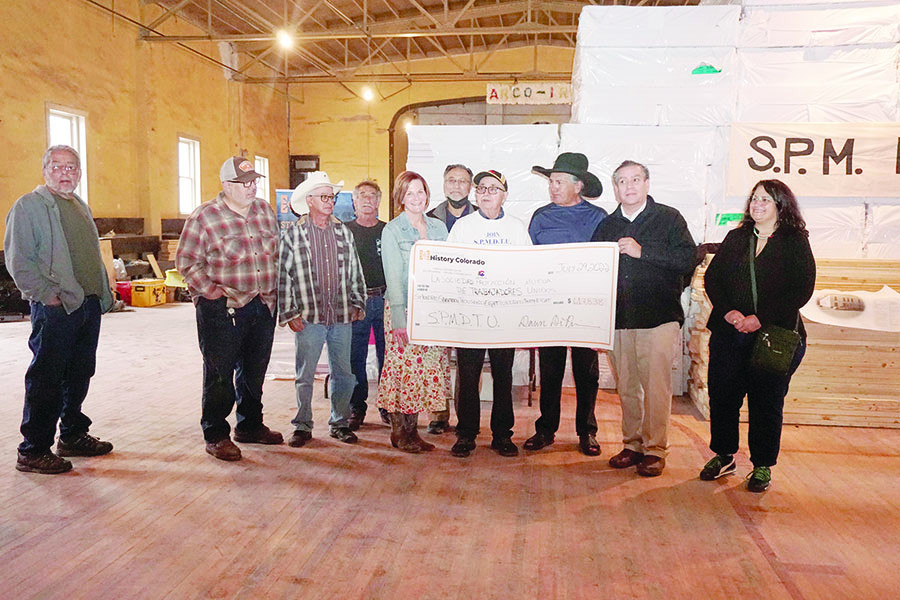SPMDTU continues on journey toward restoration

ANTONITO — In what Herman Martinez described as a “bright moment”, last week, people associated with the historic SPMDTU building in Antonito were presented with a check from History Colorado for $617,838 in support of restoring the landmark site to its former glory, bringing the total raised so far to $1.3 million.
“The building's restoration and construction project are now underway – Oh how refreshing!” reflected Martinez in an email to the Valley Courier following the ceremony. Herman Martinez is a long-standing member of SPMDTU and sits on the board of directors for the Sangre de Cristo National Historic Area, one of the funders of the SPMDTU restoration.
“Smiles from afar and up-close greetings that echo within the hollow interior of la sala/Meeting Hall. The moment all made possible esta mañana/this morning by the magic of one individual, Antonio Esquibel, hermano/member de La SPMDTU (Concilio No. 7 de Denver/Local Council No. 7).”
Dr. Antonio Esquibel, whom Martinez credits as the project’s “master mind”, unified numerous grantors and wrote the grants that led to funding.
The building is impressive. Standing more than two stories tall, the adobe and stucco structure commands the attention of anyone traveling down Main Street in Antonito. The tall, red, block letters S.P.M.D.T.U. above the date 1925 only add to its dignity and bearing.
No explanation of what the letters stand for is provided on the building but neither is an explanation needed. Many of those who gathered for the ceremony last Friday are very familiar with what the letters signify – La Sociedad Protección Mutua de Trabajadores Unidos (Society for Mutual Protection of United Workers). They also know – from personal experience – what the building stands for, what has happened there over the years and what its presence has signified to their community and culture for the past 122 years.
“I was here all the time when I was a kid.”
“We used to stand outside and look through the windows over the heads of all the people and watch boxing matches.”
“I was married here. This is where my daughter had her quinceañera.”
Martin Gonzales, retired District Judge for the 12th Judicial District, added a key perspective to the origin of La Sociedad.
“SPMDTU is the oldest Hispanic civil rights organization in the country,” he said. “We believe they were behind the Maestas case, which was the first desegregation case involving Hispanics in the country.”
Pre-dating the landmark case Brown v the Board of Education by 32 years, the “Maestas case” resulted in the desegregation of Alamosa public schools in 1922.
The history of SPMDTU Judge Gonzales referenced began with a man named Celedonio Mondragón, commemorated in a bronze statue located just south of the building.
According to Dr. Esquibel, Mondragon and six others formed a mutual aid organization that sought, through non-violent actions, to combat the exploitation of Hispanic workers by land barons, mine owners and the railroads, which was rampant 122 years ago.
The organization was “secretive” with a new member allowed only through invitation by a current member.
“It was very closed,” Esquibel told the Valley Courier. “In 1900, if you were advocating to form a union of Spanish-speaking people, it could get you hanged. So, it had to be secret. That’s why people didn’t know about it. We had to move from house to house to meet until this building was built.”
But, Esquibel said, taking such an enormous risk did not deter Mondragón from doing what he set out to do. “He traveled to sixty-three different places to start concilios locales (local councils). Sixty-three places, in a horse and buggy.”
Ultimately, SPMDTU would have local chapters spreading across the three states of Colorado, New Mexico and Utah. Even with the passage of time, the building continues to hold a place of prominence.
“If you talk to Hispanic people throughout the valley, they’ll have some connection to this building. Their fathers, their grandfathers, their uncles – someone in their family was a member,” he said.
As a telling example of all that La Sociedad meant to the lives of its members, Esquibel leads the way to a room off to the side. An American flag stands in the corner. A model of the SPMDTU insignia sits on a table at the front of the room. An old black and white photo of a relatively young Celedonio Mondragón hangs on the wall. Equibel then opens the heavy door to a solid cement vault built into the wall.
“Nobody would sell insurance to Hispanics back then, so they created their own insurance company,” he says. “This is where they stored the money.”
Even without the members of La Sociedad recalling former days, the building still tells its own story.
The faded red lines on the professional-grade wooden floor where basketball games were played. The hole cut high in an interior wall for the projectionist’s booth, At the opposite end of the large building, an elevated stage where there were performances of plays, poetry readings and bands for the dances that were held.
And now, a new chapter in the story is being written.
Previous grants from the State Historical Fund and the Sangre de Cristo National Heritage Area of Alamosa funded design and engineering work plus, thanks to the high-quality work of Scheuber and Darden Architects and local general contractor Joe Torres with Torres Builders, all 26 outside windows, outside doors, the entrance and the vestibule have been restored.
Recent funding will enable restoration of the exterior; stabilization of the roof, northeast corner of the building, stairs, floors and stage; gender neutral/ADA restrooms; a heating system; construction of an all-electric food service area; wall painting and conversion of the office into an SPMDTU Museum/Visitors Center and Education/Research Center.
Plans for the future also include EV charging stations and solar panels.



